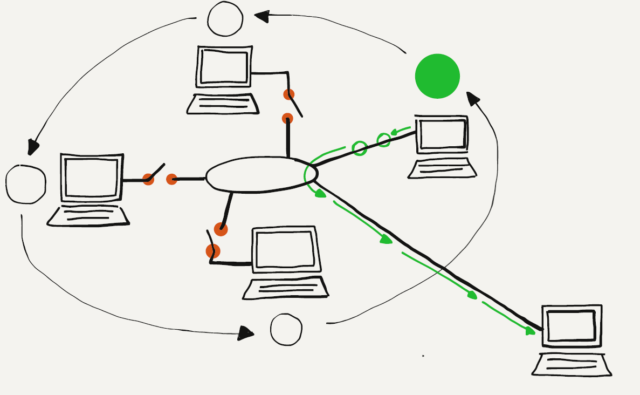Sometimes when a link layer has many transmitting stations and needs to operate at near 100% efficiency for long periods of time, the design takes a different approach. In this approach, there is a “token” that indicates when each station is given the opportunity to transmit data. Stations cannot start a transmission unless they have the token. Instead of listening for “silence” and jumping in, they must wait for their turn to come around.
When a station receives the token and has a packet to send, it sends the packet. Once the packet has been sent, the station gives up the token and waits until the token comes back to it. If none of the stations have any data to send, the token is moved from one computer to the next computer as quickly as possible.
A group of people sitting around a meeting could communicate without ever interrupting each other by having a small ball that they pass around in a circle and only allowing the person who has the ball to speak. When you get the ball and have something to say you talk for a short period (transmit a packet of words) and then pass the ball on.

The “try then retry” CSMA/CD approach works very well when there is no data or when low or moderate levels of data are being sent. But on a token-style network, if there is no data being sent and you want to send a packet, you still have to wait for a while before you receive the token and can start transmitting. When you finish your packet you have to wait until the token comes back before you can send the next packet. If you are the only station that wants to send data, you spend a good bit of time waiting for the token to come back to you after passing through all of the other stations.
The token approach is best suited when using a link medium such as as a satellite link or a undersea fiber optic link where it might take too long or be too costly to detect a collision. The CSMA/CD (listen-try) is best suited when the medium is inexpensive, shorter distance, and there are a lot of stations sharing the medium that only send data in short bursts. So that is why WiFi (and CSMA/CD) is so effective for providing network access in a coffee shop, home, or room in a school.
The token approach is best suited when using a link medium such as as a satellite link or a undersea fiber optic link where it might take too long or be too costly to detect a collision. The CSMA/CD (listen-try) is best suited when the medium is inexpensive, shorter distance, and there are a lot of stations sharing the medium that only send data in short bursts. So that is why WiFi (and CSMA/CD) is so effective for providing network access in a coffee shop, home, or room in a school.